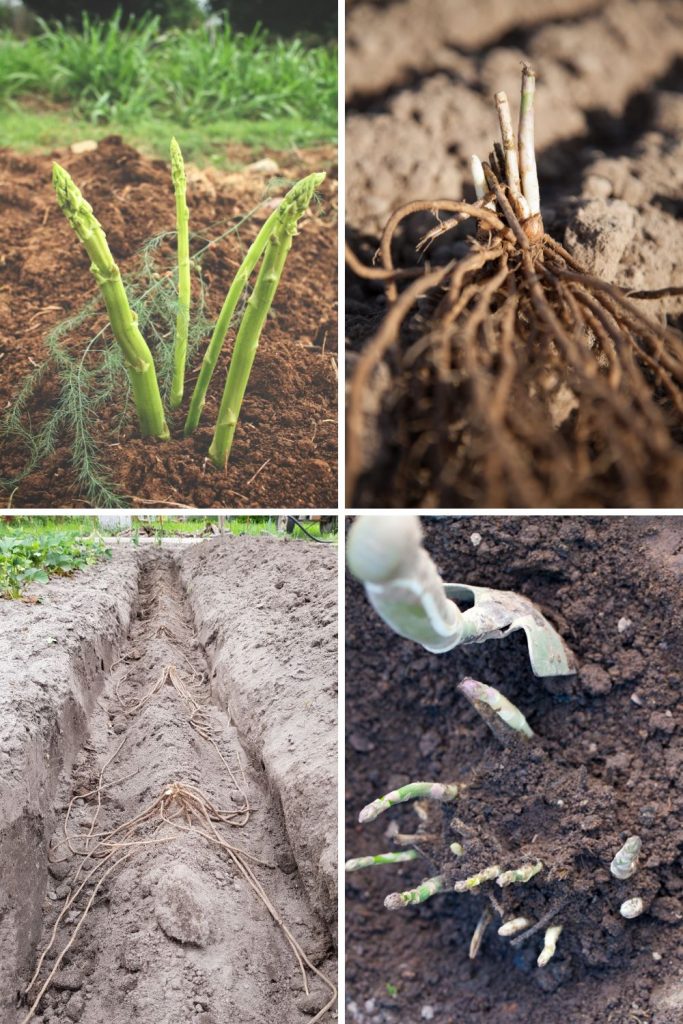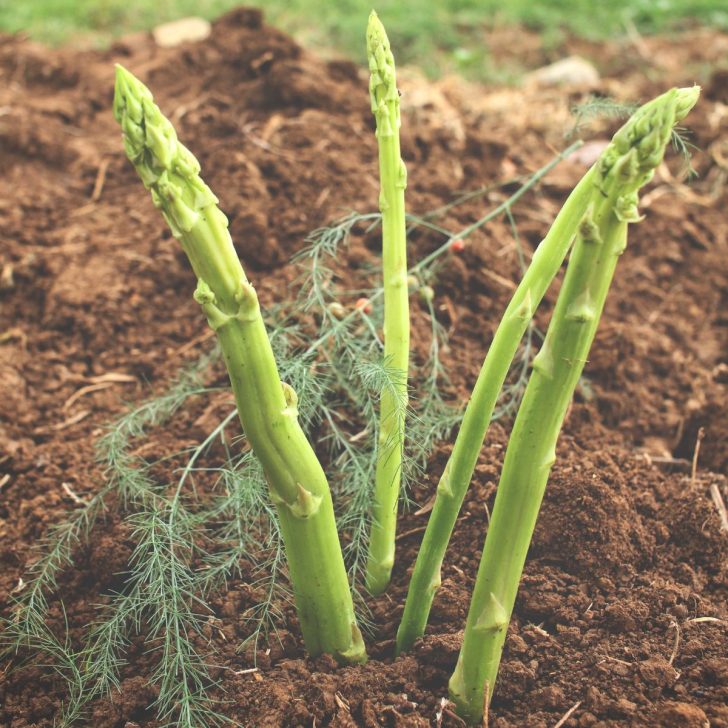And When is Asparagus Growing Season?
If you’re wondering when to plant asparagus, we’ll cover that in this short article on the asparagus growing season.
If you’re new to planting asparagus, you’ll need to be patient but the payoff is well worth it. Asparagus is a perennial vegetable that takes a few years to establish but can provide a harvest for up to 20 years or more.
When to Plant Asparagus by Zone
Asparagus grows best up to USDA hardiness zones 3-8. However some are successful in growing asparagus in Florida in zone 9 with special care.[1]https://ediblelandscaping.com/careguide/Asparagus/#:~:text=Asparagus%20does%20grow%20well%20in,some%20fresh%20asparagus…%22
Here are some general guidelines on when to plant asparagus crowns by USDA Hardiness Zone:
- Zones 3-4: Plant asparagus in early to mid-spring when the soil temperature is at least 45°F (7°C) and frost is no longer expected. This is typically between late April and early May.
- Zones 5-6: Plant asparagus in mid to late spring when the soil temperature is at least 50°F (10°C) and the last frost has passed. This is usually between mid-April and mid-May.
- Zones 7-8: Plant asparagus in early spring, around late February to early April, when the soil temperature reaches 50°F (10°C) and there’s no risk of frost.
- Zones 9-10: Plant asparagus in late winter to early spring, between January and March, when the soil temperature is around 50°F (10°C) and before the weather gets too warm.
Remember that these are general guidelines and local conditions, such as microclimates and soil conditions, can affect planting times.
Can You Grow Asparagus in Zones 9 and 10?
Yes, you can grow asparagus in USDA Hardiness Zones 9 and 10, although it may be more challenging compared to growing it in cooler climates.
Asparagus is a perennial vegetable that prefers cooler temperatures, and it requires a period of dormancy during winter to produce a good harvest the following spring. In Zones 9 and 10, winters can be mild, which might affect the dormancy period.
Tips for Growing Asparagus in Zones 9 and 10:
- Choose the right variety: Opt for heat-tolerant and disease-resistant asparagus varieties that are better suited for warmer climates. Examples include ‘UC 157’, ‘Jersey Giant’, and ‘Apollo’.
- Planting time: Plant asparagus crowns in late winter to early spring, when soil temperatures are between 50°F and 60°F (10°C to 15.5°C).
- Soil preparation: Asparagus grows best in well-draining, slightly acidic soil with a pH between 6.0 and 7.0. Prepare the soil by incorporating organic matter such as compost or well-rotted manure to improve drainage and fertility.
- Provide shade: In Zones 9 and 10, asparagus may benefit from some afternoon shade to protect it from intense heat, especially during the summer months.
- Watering: Asparagus requires consistent moisture, especially during the growing season. Make sure to water regularly, providing about 1 to 1.5 inches of water per week. In hotter climates, you may need to water more frequently to maintain soil moisture.
- Mulching: Apply a layer of organic mulch, like straw or shredded leaves, around the asparagus plants to help conserve moisture, suppress weeds, and maintain a cooler soil temperature.
- Fertilizing: Apply a balanced fertilizer or well-rotted manure annually in the fall or early spring to provide necessary nutrients for healthy growth.
By following these tips and adapting your gardening practices to the local climate, you can successfully grow asparagus in Zones 9 and 10. Keep in mind that asparagus can take up to three years to establish itself and produce a substantial harvest, so patience is key.
Beyond that, we’ve found that it’s always helpful to consult with local authorities, such as your area agricultural extensions service “ag. agent”. Also, to join local gardening groups in person and/or on Facebook where you can ask questions (and share answers) based on the experience of others in your more immediate climate.
Plant in Well Draining Soil, Then Be Patient!
It’s essential to prepare the planting area properly and ensure good drainage, as asparagus roots don’t tolerate standing water. Keep in mind that asparagus takes a few years to establish, and you should avoid harvesting the spears until the third year to ensure a robust and productive plant.
See more on planting and growing asparagus here.
When is Asparagus Growing Season?
Asparagus growing season in North America generally spans from late winter or early spring through early summer, depending on your location and local climate. Here’s a rough timeline of the asparagus growing season in different regions:
- Northern regions (USDA Hardiness Zones 3-4): Asparagus starts to emerge in late April or early May and continues to grow through June. The harvesting season usually lasts for about six to eight weeks.
- Mid-latitude regions (USDA Hardiness Zones 5-6): In these areas, asparagus begins to grow in mid to late April and can be harvested from late April through early June.
- Southern regions (USDA Hardiness Zones 7-8): Asparagus growing season starts earlier in these warmer zones, typically from late February to early April. Harvesting can begin in late March or early April and continue until late May or early June.
- Warmest regions (USDA Hardiness Zones 9-10): In these zones, asparagus starts to grow in late winter, around January or February. The harvesting season can begin as early as February and continue through April or May.

Now that you know more about when to plant asparagus and its growing season, you can find out more on the how-to plant and grow asparagus here.
I’m LeAura Alderson, a garden, herb and plant enthusiast with a passion for discovering the many edible and medicinal benefits of the plants all around us, including the weeds! I’m a writer, editor and media publisher for our family of websites.
While I was certified in fitness and life coaching, I am NOT a health practitioner. However, I’m a lifelong health enthusiast, with a keen interest in healthy, organic foods and making home remedies and the content we share is from our own experience and usage as well as that extracted from scientific research so that you can explore further on your own.
Always seek the advice and guidance of your health practitioners first and foremost.
As a family we’re steadily expanding our gardening, experimentation and knowledge around all things gardening, edible landscaping, fresh organic foods and self sustainability with farming in our future. I also own and manage iCreateDaily.com, a site all about transformation through creation, and the power of positivity, optimism and mindset.
References

